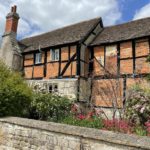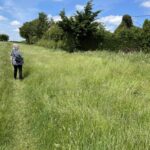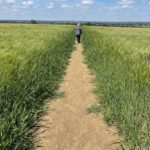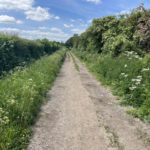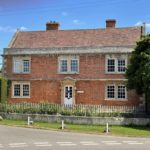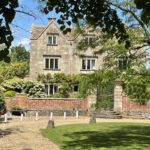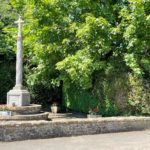Head for BA14 6EW. This is a 3 mile easy walk around Steeple Ashton on relatively flat ground – focused on a fine Wiltshire village. (Click map to enlarge. Arial view here). Click here to download/print PDF. (There is a GPX route option here for phone/tablet download. But only follow this link after watching this GPX help video). Friendly warning: all files relating to walks are published here on good faith but on the understanding that users must be responsible for their own safety and wellbeing.
(Routes from map points + metres to next point)
Parking should be possible near Church, Then head for High Street
1: Turn right and walk. Turn left into Sandpits Lane after 400m
2: Take first right off this lane onto Gullivers Hill. And then right onto Gullivers Lane which becomes a field path. Walk forward, finally crossing open field. 820m
3: At T-junction turn left down Mudmead Lane. 1.1km
4: At end turn right into Sandpits Lane back to the village 1.6km. [Consider walking to ‘Start’ and village shop [11] for refreshment]
The pictures below are in the order things were seen on this walk. Clicking on any one will enlarge it (and the slideshow)
The walk
The suggested route starts and finishes in the centre of the village. And there are few Wiltshire villages that provide a more agreeable focus for a circular walk. After passing through some housing, there is small amount of (straightforward) field walking but, thereafter, it’s paved lanes. No challenging stiles, fences or traffic.
The village
From the 13th until the 16th century this seems to have been a sizeable and prosperous town. That history is partly visible now in its cluster of streets with their variety of dwellings reflecting five centuries of a community – and so furnishing an impressive gallery of styles and materials. For more details, see this suggested walk around the village. In the centre there is a village green with market cross, but also an intriguing 1773 octagonal blind house – a Wiltshire term for a lockup where local offenders could be held until the time to deal with them.
Steeple Ashton’s prosperity may have been affected by a decline in the woollen cloth trade. However, records indcate that there was a significant fire in the town in the early 16th century. This doubtless eroded some of the industry of the place. Nevertheless, today this is a lively, if smaller, community (see them in full song here) and much of the village’s former glory is well preserved in architectural terms (e.g. pictures 2 and 8). As ever in this area, the fine country houses are projecting the wealth of former clothiers.
So now there is less commerce and industry. Just one shop (pic 11) – a place where you will get a warm welcome including some homemade refreshment. Although alternative refreshment is available at the Longs Arms further down the street: a 17th century pub with a good garden. So the ubiquitous Long family of Wiltshire are memorialised through this Inn. This is a link to fine food and ale that makes some historic sense. For Richard Long purchased the Manor House in 1799 and was so delighted he treated the locals to “fine ox roasted whole” on a bonfire accompanied by bread and cheese and two hogsheads of strong beer.
The church
St Mary the Virgin church (pic A) is well worth a visit with its abundance of pinnacles, buttresses, battlements and gargoyles: it is judged by some to be “one of the finest perpendicular churches in the country”. If you need convincing, have a look at this drone video. It is a classic ‘wool trade church’. Which simply means its existence owes a lot to the largesse of wealthy clothiers. Not that there relationship with the church was always one of piety and salvation: the richness of the porch design reflects their practice of informally conducting business there, as well as worship.
Two wealthy clothiers (Long and Lucas) paid for an aisle each between 1480 and 1500. More humble parishioners pitched in for the nave and its tower. That prominent tower formerly carried a steeple (hence the village name, it was previously just ‘Ashton’). That steeple reached186ft – thereby making it’s height second only to Salisbury cathedral in the county (if not the country). Sadly, in July 1670 this spire was struck by lightning and again in October when it was being repaired. This was taken as divine omen, so the spire recovery project was abandoned. The manor (pic 9) is close by the church. It is a Grade II* Jacobean house (1647?) with extensive gardens; recently noticed on sale for £2m (much more information here).
Often the historic influence of the church on village communities was directed via the universities. In the present case, it seems that Steeple Ashton has a connection with Magdalene College Cambridge. It is a case that illustrates how that connection sometimes worked. Drue Drury, an ex-student of Magdalene, bequeathed to the college the vicarage and rights of vicar nomination along with a slice of the tithe income in 1697. The will dictated that church vacancies should be offered to the three longest serving Fellows in turn (the actual succession of vicars is described here). The income also provided for the college’s Norfolk Travelling Fellowship, whereby college members were supported in overseas travel. There is no evidence that this college good fortune brought any educational benefit to the people of this village. Moreover, these nominated Fellows contributed to the resented pattern of non-residence characteristic of such livings in the seventeenth and eighteenth century.
And wool!
Steeple Ashton is one of many in this part of Wiltshire that flourished thanks to the medieval wool trade (coupled with ecclesiastical influence in this case). At least it flourished until the early seventeenth century when the Wiltshire trade rather collapsed. Robert Long and Walter Lucas were two of its particularly successful clothiers – they basically rebuilt the church between 1480 and 1500, making it the distinguished building it is today.
It might be expected that a large village like this would have grown to rival one of the nearby market towns (Trowbridge, Melksham etc). Unfortunately, the lack of available water power from rivers meant that more advanced cloth making moved away from Steeple Ashton. Notably to the villages on the River ByBrook. Reference to the wool trade always surfaces in historical accounts of Wiltshire communities, including their rise and fall. A little useful background on this industry is set down here. in simple and general terms
In the end, this place must rank as one of the most agreeable villages in the county – and thankfully for visitors, it doesn’t attract the same crowds as the rather contrived cosiness of “most beautiful in England” nearby Castle Combe (that did have water power for the clothiers’ fulling mills and thereby was once more industrial than its present ‘pretty’)

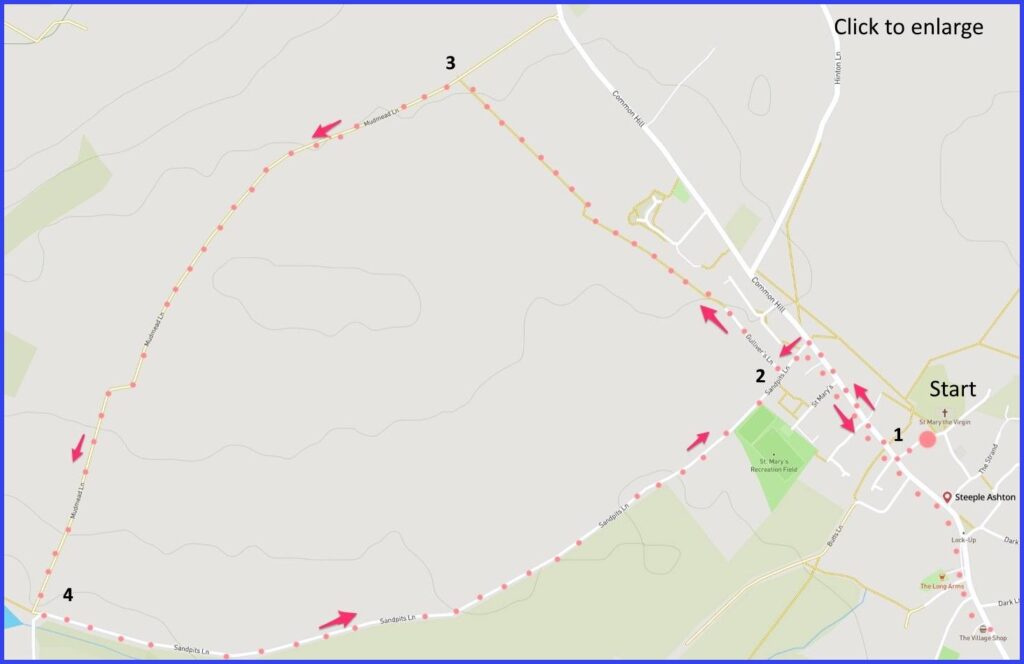
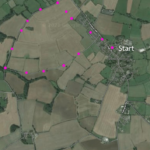
![[A]](https://wiltshirewalks.com/wp-content/uploads/2021/10/01SAsh-150x150.jpg)
